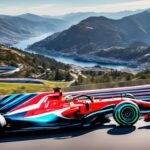The role of tracks in simulated racing experiences is crucial to creating realistic and immersive environments for drivers. In the world of virtual racing, the design and layout of tracks play a significant part in how drivers engage with the simulation. From replicating famous circuits to creating unique, fictional designs, tracks serve as the backbone of any racing game or simulator. In this post, we will explore the role of tracks in simulated racing experiences and how they affect gameplay, driver performance, and overall immersion.

Authenticity of Track Design
One of the key elements of a good simulated racing experience is the authenticity of the track design. Many racing simulations, such as those in Formula 1, NASCAR, and MotoGP, strive to replicate real-world tracks. These simulations aim to mimic the layout, elevation changes, and track surfaces of famous circuits like the Monaco Grand Prix or the Nürburgring.
Accurate representations of these tracks allow virtual drivers to feel like they are racing on the same circuits as their real-life counterparts. The more realistic the track, the more immersive the experience. For this reason, game developers and simulation platforms invest heavily in laser scanning and photogrammetry technologies to recreate tracks down to the smallest detail. This attention to detail enhances realism and allows drivers to experience the challenges of the track as if they were physically present.
Track Layouts and Their Impact on Racing Strategy
Track layouts play a significant role in shaping the racing strategy in simulations. Different track designs require different driving techniques and approaches. A circuit with tight corners, like Monaco, demands precision and focus. On the other hand, a high-speed track, like the Circuit de la Sarthe, requires aggressive acceleration and braking.
These layouts influence the way drivers plan their race strategy. In simulated racing, drivers must adjust their tactics based on the track’s features. For example, a driver may focus on braking points and cornering lines on a technical circuit, while prioritizing speed and overtaking opportunities on a faster track. The design of the track directly impacts how drivers approach each lap, testing their ability to adapt to changing conditions and outsmart their opponents.
Realism in Virtual Racing Environments
Simulated tracks contribute greatly to the realism of virtual racing. Advanced simulations strive to replicate not only the physical features of the track but also the behaviour of the vehicle on it. Factors such as tyre grip, surface texture, and even weather conditions are accurately modelled to create a lifelike experience.
The track’s surface plays a key role in how the car handles. For instance, some tracks simulate changes in grip due to weather or wear during a race, just like on real-world circuits. If the track is wet or if it’s raining, drivers must adjust their driving style to prevent spinning out or losing control. Similarly, some tracks incorporate elevation changes, which impact braking points and throttle control. These realistic factors make it necessary for drivers to adjust to the track’s evolving conditions throughout the race, adding an extra layer of challenge to the experience.
Creating Unique Fictional Tracks
While real-world circuits dominate simulated racing, some games and simulators offer fictional tracks designed to test the skills of drivers in new ways. These tracks often feature unique layouts, which may combine elements from different types of circuits. For example, a fictional track may have long straights for high-speed racing and tight corners for technical maneuvers. These creative designs push drivers to learn new driving techniques and keep the virtual racing experience fresh and exciting.
Fictional tracks also allow for endless possibilities in track design. They can challenge drivers to master new environments that do not exist in the real world, providing a different kind of challenge compared to traditional racing circuits. These tracks can be futuristic, with gravity-defying turns, or natural, set in scenic landscapes that test both the driver’s skill and endurance.
Track-Specific Skills and Mastery
In any racing simulation, mastering a track is a key component of success. Virtual drivers must learn the ins and outs of each circuit to maximize their performance. This involves memorizing braking points, understanding racing lines, and adjusting car settings to suit the track’s layout. Mastery of a track, whether real or fictional, requires time, practice, and dedication.
Virtual racing allows drivers to practice tracks repeatedly without the risk of injury or car damage, unlike real-world racing. This makes it easier for drivers to refine their skills and improve lap times. As drivers get more familiar with the track, they can experiment with different strategies to gain an edge over opponents, learning the best ways to attack corners, utilize straightaways, and navigate complex sections of the track.
Conclusion
In conclusion, tracks play a vital role in shaping the simulated racing experience. Authentic track designs bring realism and excitement to virtual racing. The layout of each track impacts strategy, skill development, and performance. Whether real or fictional, tracks provide challenges that test a driver’s abilities and adaptability. Through attention to detail, advanced technology, and creative design, simulated tracks continue to evolve, offering drivers the opportunity to improve their racing skills in a virtual environment. As the technology behind simulations improves, we can expect even more exciting and immersive tracks in the future.









